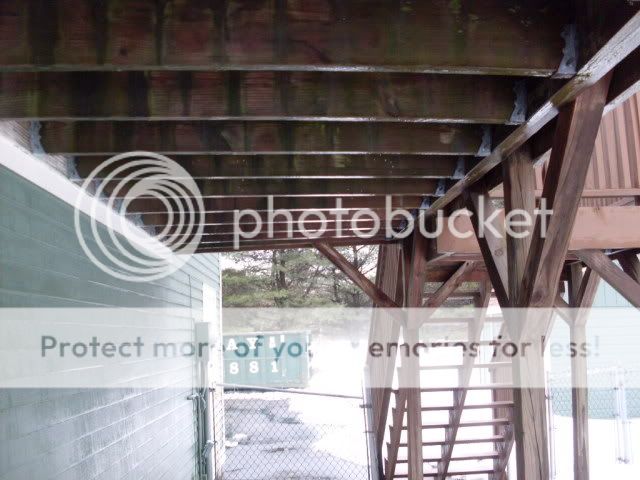Dream home turns into nightmare: Water damage, mold force young Wakefield family out of new house
By JOEY CRESTA
**Related Articles and Media**
Article: [UNH study: Rural children more likely living in cohabiting households](http://www.fosters.com/apps/pbcs.dll/article?AID=/20090703/GJNEWS_01/707039958)
WAKEFIELD — When Chad and Tasha Bennett moved into their home at 111 Crabapple Drive on Mother's Day weekend, they thought they were entering their dream home.
Instead, it has turned into a nightmare.
Town building inspector and health officer Arthur Capello condemned the house — a 12-year-old two-story contemporary — on Thursday, deeming it unsafe to live in due to a number of issues. Now, they own a $130,000 home with at least $80,000 worth of damage they cannot afford to fix.
The problems began three weeks after moving in. A few days of heavy rain caused “buckets of water” to leak into the basement through the foundation. While searching for the root of the problem, the Bennetts pulled off the outer vinyl siding, uncovering water damage and mold. In the basement, behind two layers of insulation and a layer of plastic, they found rotting sideboards and more mold.
An $800 test revealed four kinds of mold growing on the walls outside, from the ground up to the roof and throughout the basement, Ms. Bennett said.
“Every day things seem to be getting worse and worse,” said Capello, who was working on a notice to vacate Thursday afternoon. In addition to mold and water damage, there are structural issues and fire hazard concerns that lead him to believe the house is now unlivable. He called the footing, or foundation base, “questionable.” To fix the problem, the foundation has to be dug up, outside sheeting needs to be replaced and the moldy basement has to be cleaned and reinspected before the house is livable again, he said.
The Bennetts said the footing was made of wood, rather than the usual concrete reinforced with steel.
“How can a house be built like this?” asked Bennett, adding the house started to lean forward and sink into the ground because of the poor foundation work. “This house has to be lifted up take all the blocks out. It’s more cost-effective to tear it down.”
Capello said he does not see any signs the issues existed before the Bennetts moved in and suggested the recent rainfall could have “aggravated the situation,” but he was not certain. He previously gave them until the winter to either get the house fixed or move out. But after a return visit Thursday morning, he determined they needed to get out “as soon as they can.”
“There was water around electrical sockets in the children’s bedroom,” Ms. Bennett said.
It was hard news to swallow for a young couple that had just purchased their first home. Tasha, 23, and Chad, 24, had worked for three years to build up their credit so they could buy a home. They looked at a number of places, where either the price or the home did not fit their needs. When they found their home on Crabapple Drive, they thought it was the right place for them, their children, Vivianna, 3, and Timothy, 2, and their dogs.
A $420 home inspection led them to believe everything was fine. The home passed. Tasha Bennett said the inspection company’s only suggestion was to budget for a new roof “down the road” because it had apparently suffered damage during last winter’s ice storm.
The Bennetts would like to hold the home inspection company culpable for the inspection, but as Tasha Bennett said, “There are so many loopholes in their contract,” adding the inspection company told them afterward they do not look for mold, code violations or hidden problems. The Bennetts were told they should have sought another inspection before buying the home.
“We got the best inspection — the most expensive anyway. They didn’t mention any of this… How many people can afford more than one $400 inspection?” Bennett said.
And Tasha Bennett added, “Why would you go and pay to have another inspection done when you’re told there’s no problems?”
“I can’t believe this is happening. It makes me so angry… I don’t wish this on anybody,” Bennett said. “I’m kind of hoping for an Extreme Home Makeover. We need it. We got scammed wicked.”
The Bennetts have not received much support from others involved. When they called their own real estate agent, they were told, “It happens to the best of us, kid,” Bennett said.
“Arthur’s (Capello) doing a great job. He’s the only one helping us. He’s been the best help,” he added.
Capello said he did not have any words he could say to comfort the family. He said he has never seen a home the age of theirs with the same extent of damage. He said there is “not a lot I can do” because “it’s a civil matter.”
“We’re not trying to badmouth anyone. We just want to let people know about the problem and to be careful,” Tasha Bennett said.
As of Thursday evening, the family did not know where they were going to stay. Tasha Bennett said their closest family is in Bangor, Maine. Her brother is currently attending college in Portland, but as she said, “We can’t stay in a dorm.”
The Bennetts have contacted a lawyer about suing the previous owners. They said they either want them to help pay for the damages or buy the house back. If that does not work, they will have to foreclose on the home, “ruining his (Chad’s) credit for another seven to 12 years,” Tasha Bennett said.





